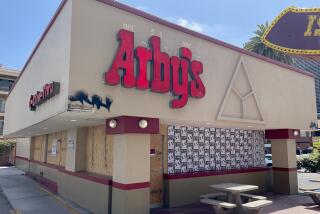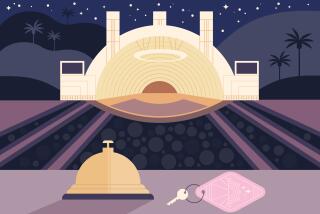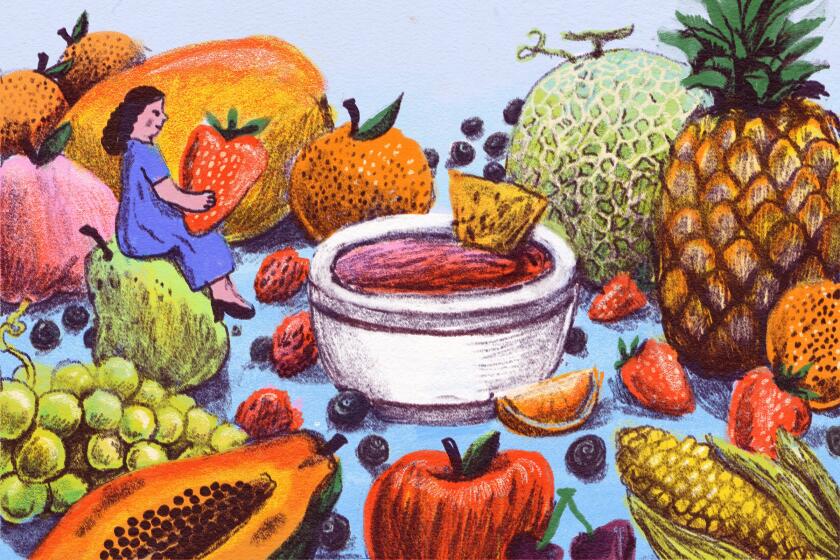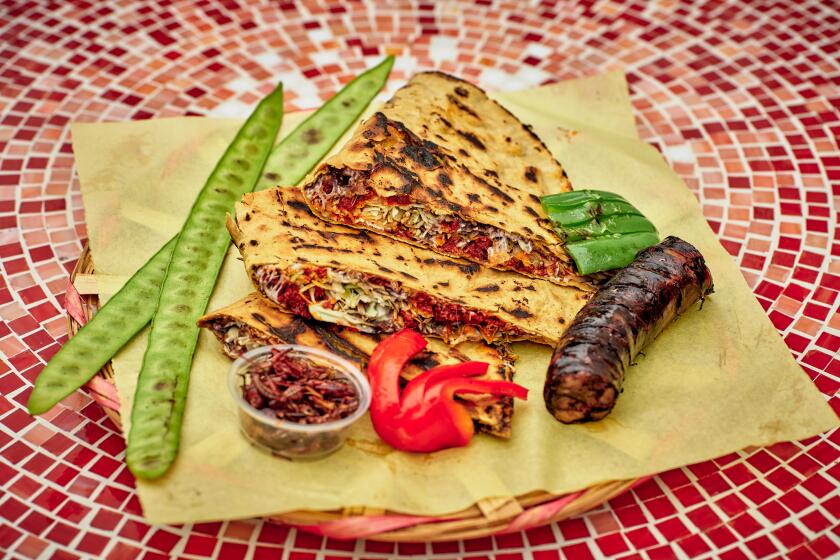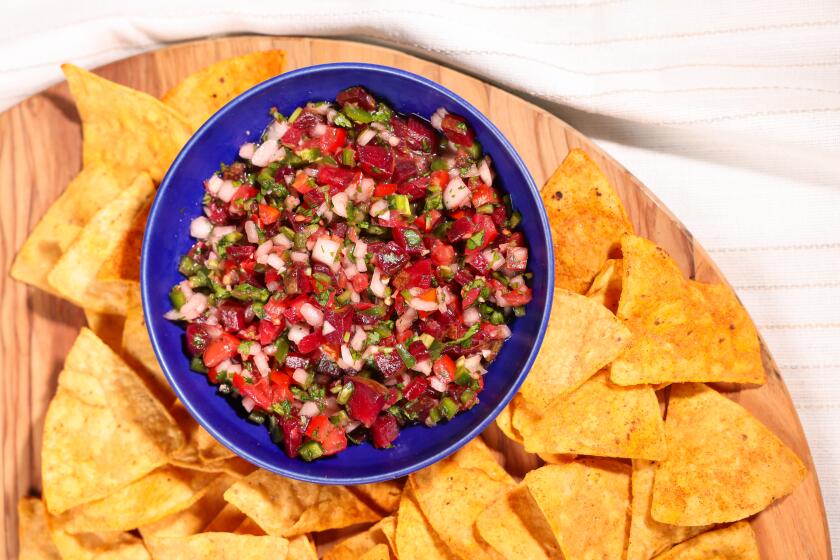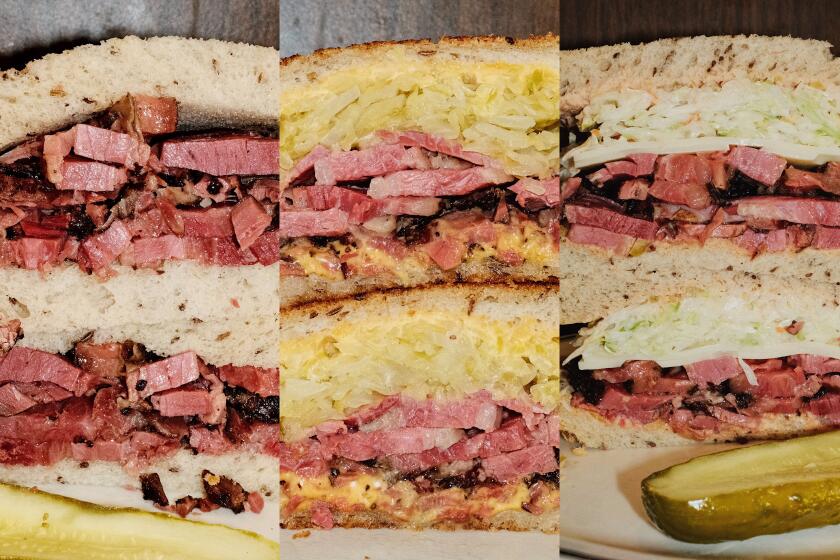Brandstatter brought the party to old Hollywood
Before Chasen’s and the Brown Derby, way before Sam Nazarian or even Wolfgang Puck, the first restaurant guy who catered to Hollywood was Adolph “Eddie” Brandstatter. He had the “Brandstatter touch”: one part dapper European suavity — he brought a sheen of elegance to the rough-edged Hollywood of the 1920s — and one part straight-up charisma. Wherever Eddie was, that was the party.
Brandstatter also helped establish the sort of menu that dominated upscale restaurants around here up to the 1960s: quasi-French Continental cuisine along with some real French dishes (Brandstatter, born in France, always offered a cheese course), a miscellany of local favorites — borscht, enchiladas, spaghetti and meatballs, mince pie — and diet foods: nonfat ice cream and Marlene Dietrich’s favorite chicken burger.
He had worked in Paris, London and New York restaurants before moving to Los Angeles in the 1910s. In 1914, as he often reminded people, he introduced the hot and cold buffet to L.A. Angelenos were crazy for cafeterias, and it probably read as an upscale equivalent. Most of his restaurants would feature buffets.
Building a clientele
By 1920, he was managing the palatial Sunset Inn in Santa Monica. At the time, actors made pitifully small salaries, so world-famous stars were living in apartments or even hotel rooms, with no good place to socialize. Brandstatter put the Sunset Inn at their disposal. Wednesday nights were Photoplayers’ Frolics, and he extended credit to many future stars, earning their eternal loyalty.
In 1923, he rented a swank upstairs room at Hollywood Boulevard and Highland Avenue and turned it into the Café Montmartre — officially, “Brandstatter’s Café Montmartre in Hollywood.” A newspaper ad described it as “the center of Hollywood life, where everybody worthwhile go [sic] to see and be seen.”
Maybe Eddie wrote that advertising copy himself. At any rate, it was no exaggeration. The Montmartre was the place to see stars, particularly on Wednesday and Friday nights, when gossip columnist Louella Parsons would table-hop in search of juicy news. It had lots of special events; Clara Bow, the ultimate flapper, once won a dance contest there.
Of course it had dancing. The ‘20s were the dance age — any self-respecting restaurant above the diner level had a dance floor and an orchestra. And when people weren’t dancing, they were watching a floor show, which consisted of other people dancing. At lunch, the Montmartre featured a “bachelors’ table” of good-looking men who were available to dance with any lunching lady who felt like cutting a rug.
The liquor flowed
Prohibition was in force, but Brandstatter didn’t expect his customers to endure a night of dining and dancing stone-cold sober. Everybody brought a hip flask, and if you drank it dry, there was a bootlegger on the premises to top it off for you, though people grumbled about his prices.
On the other hand, you were at the Montmartre, the center of the universe. Outside, people were lined up down the block hoping for a chance to dine with the stars. So shut up and pay.
In 1929, Brandstatter made a disastrous mistake by opening a private venue, the Embassy Club, for his Hollywood friends. Now that they had paid their dues, the stars started partying at the Embassy Club instead of the Montmartre, and since the stars weren’t dining there anymore, ordinary people stopped coming too.
On top of that, by 1932 a lot of Brandstatter’s old friends were no longer stars and couldn’t afford their dues to the Embassy Club. His solution was to open it to the general public, with the result that the stars pulled out.
That year he declared bankruptcy and, after he sold the Montmartre, was convicted of theft for having absconded with assorted furnishings, including drapes, china and a large statue of a nude woman (described in the Los Angeles Times as “a cherished art object”).
He bounced back in 1933 with the even grander Sardi’s, an Art Deco palace at 6315 Hollywood Blvd. In 1936, it was destroyed by a fire. Once again he bounced back, though a little less high, with the Bohemian Grill on Vine. He had been planning more restaurants (altogether he opened about 10 in a 20-year period) when he committed suicide in 1940.
It’s hard to avoid the suspicion that he was what we would now call bipolar, with his expansive periods of new projects alternating with catastrophes. This would explain his charisma, and also episodes like his cutting through the wall between the Montmartre and a jewelry shop next door … without telling the landlord. The grandiosity of a manic phase might also explain why his newspaper ads never bothered to mention the Montmartre’s address (6757 Hollywood Blvd.).
On the other hand, that might have been a marketing ploy, like Ma Maison’s having an unlisted telephone number in the 1980s. Or, for that matter, the exceptionally inconspicuous entrance of today’s Montmartre Lounge, a bar specializing in private parties for Hollywood people in the old Montmartre location, which has no sign but the letters ML.
Eddie’s spirit lives.
More to Read
Eat your way across L.A.
Get our weekly Tasting Notes newsletter for reviews, news and more.
You may occasionally receive promotional content from the Los Angeles Times.

